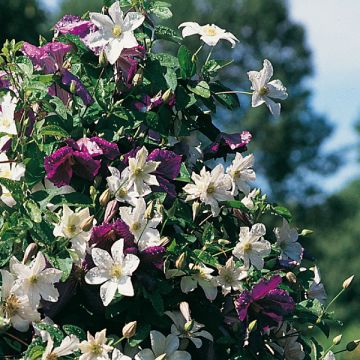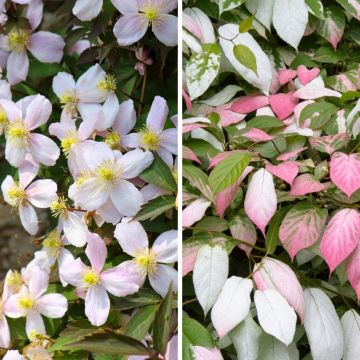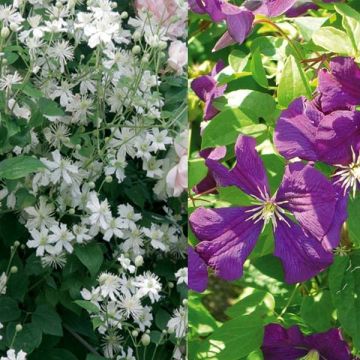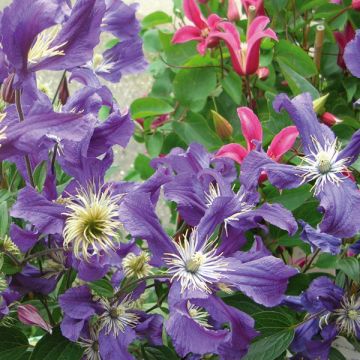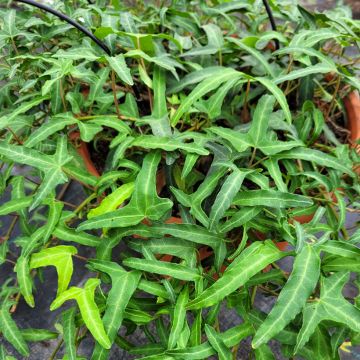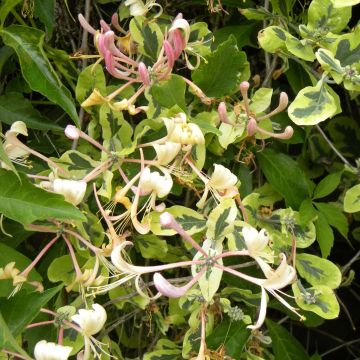

Dynamic Duo - Honeysuckle and Clematis Collection
Dynamic Duo - Honeysuckle and Clematis Collection
Lonicera, Clematis
The young plant of clematis arrived completely dried out. I planted it, but I'm not sure if it will revive.
Armelle, 22/02/2021
This plant carries a 6 months recovery warranty
More information
We guarantee the quality of our plants for a full growing cycle, and will replace at our expense any plant that fails to recover under normal climatic and planting conditions.
From €5.90 for pickup delivery and €6.90 for home delivery
Express home delivery from €8.90.
Delivery to Corse prohibited: UE law prohibits the import of this plant from mainland France to Corse as part of the fight against Xylella fastidiosa. Please accept our sincere apologies.
More information
Does this plant fit my garden?
Set up your Plantfit profile →
Collection items (2 plants)
Description
A formidable duo of colours! The orange and yellow flowers of Lonicera Mandarin® mingle with the dark purple inflorescences of Clematis Romantika. This wonderfully contrasting duo brings together two original and vigorous climbing plants, adorned with decorative deciduous foliage and fragrant summer flowers. Their long stems wrap around any support available to them. These climbers will then enthusiastically cover a pergola, an canopy, or take over a sad old hedge...
This duo consists of a Clematis Romantika and a Lonicera Mandarin.
The Lonicera Golden Trumpet is a very hardy, easy to grow climbing Honeysuckle, with beautiful delicately scented orange and yellow flowers. It has 4 to 8 cm long, opposite, ovate, lanceolate, deciduous, brown then bluish green leaves. From May to July, numerous 3 cm-long, orange and yellow tubular flowers diffuse a powerful and pleasant fragrance. They have two large coloured lips and expose the stamens. In autumn, red berries follow but these are toxic.
The Clematis Romantika catches the eye with the very dark shade of its abundant large velvety flowers and seduces with its good resistance to wilt disease. From June to September, flowers with 4 to 6 very dark purple petals bloom, taking on black and violet reflections as the hours go by. The centre of the flower, occupied by beautiful yellow stamens, further accentuates the dark colour of the flower. The moderate-sized, medium green, pinnate leaves with oval, glabrous leaflets, are of the viticella type. Clematis belong to the Ranunculaceae family. They are found in both hemispheres, particularly in Europe, the Himalayas, China, Australia, North and Central America. The 'Romantika' variety, introduced in Estonia in 1983, is a vigorous, resistant, perfectly perennial and hardy, woody and climbing plant that will quickly reach a height of 3 to 4 m, with a minimum spread of 1 m.
This duo will thrive in any rich, moist, well-drained soil in a sunny or semi-shaded location. Clematis like to have their feet in the shade and their heads in the sun. Although not necessary, light pruning at the end of winter is possible to balance the habit.
With its height of 3 to 4 m, this duo is ideal as a wall cover to dress up a fence, trellis, pole, pergola, or tree. In a container on a terrace, you will enjoy its fragrance even more!
Report an error about the product description
Plant habit
Flowering
Foliage
Botanical data
Lonicera, Clematis
Cultivar or hybrid
Other Climber pairs
Planting and care
The Mandarin Lonicera should be planted in autumn or spring in cool, rich and well-drained soil in a sunny or semi-shaded position. Be sure to add potting compost when planting. Water regularly and mulch the soil to keep it cool. Prune in late winter to balance the branches. Watch out for aphids!
The Romantika Clematis will appreciate a sunny or lightly shaded position near a tree, with its base in the shade. Plant it in fertile, humus-rich, cool, and well-drained soil, shading the roots and the base of the stems (with a flat tile, for example). In general, clematis wither in overly wet soil, but varieties carrying the genes of C.viticella seem to be less sensitive to this terrible disease. Plant it by covering the root ball with 3 cm of soil, in soil worked to a depth of 20 cm, lightened with good potting compost and coarse sand. After planting, cut back the clematis stems to about 30 cm from the base above a healthy pair of buds. Water regularly in the first few weeks. However, be careful not to let the water stagnate as this can cause fungi to develop at the collar. Mulch all clematis in February with garden compost or well-decomposed manure, avoiding direct contact with the stems. Train the stems, without squeezing them, until the plant grips itself. Clematis also like to grow freely on neighbouring plants. Prune in March to 30 cm from the ground.
After a few years, cover the base of your climbing clematis with a small mound of soil to reduce the risk of withering, while promoting the growth of vigorous shoots from the stump. Voles and grey worms can attack clematis and devour the stems. Aphids and greenhouse whiteflies are also potential clematis parasites.
Planting period
Intended location
Care
-
, onOrder confirmed
Reply from on Promesse de fleurs
Foolproof climbers
Haven't found what you were looking for?
Hardiness is the lowest winter temperature a plant can endure without suffering serious damage or even dying. However, hardiness is affected by location (a sheltered area, such as a patio), protection (winter cover) and soil type (hardiness is improved by well-drained soil).

Photo Sharing Terms & Conditions
In order to encourage gardeners to interact and share their experiences, Promesse de fleurs offers various media enabling content to be uploaded onto its Site - in particular via the ‘Photo sharing’ module.
The User agrees to refrain from:
- Posting any content that is illegal, prejudicial, insulting, racist, inciteful to hatred, revisionist, contrary to public decency, that infringes on privacy or on the privacy rights of third parties, in particular the publicity rights of persons and goods, intellectual property rights, or the right to privacy.
- Submitting content on behalf of a third party;
- Impersonate the identity of a third party and/or publish any personal information about a third party;
In general, the User undertakes to refrain from any unethical behaviour.
All Content (in particular text, comments, files, images, photos, videos, creative works, etc.), which may be subject to property or intellectual property rights, image or other private rights, shall remain the property of the User, subject to the limited rights granted by the terms of the licence granted by Promesse de fleurs as stated below. Users are at liberty to publish or not to publish such Content on the Site, notably via the ‘Photo Sharing’ facility, and accept that this Content shall be made public and freely accessible, notably on the Internet.
Users further acknowledge, undertake to have ,and guarantee that they hold all necessary rights and permissions to publish such material on the Site, in particular with regard to the legislation in force pertaining to any privacy, property, intellectual property, image, or contractual rights, or rights of any other nature. By publishing such Content on the Site, Users acknowledge accepting full liability as publishers of the Content within the meaning of the law, and grant Promesse de fleurs, free of charge, an inclusive, worldwide licence for the said Content for the entire duration of its publication, including all reproduction, representation, up/downloading, displaying, performing, transmission, and storage rights.
Users also grant permission for their name to be linked to the Content and accept that this link may not always be made available.
By engaging in posting material, Users consent to their Content becoming automatically accessible on the Internet, in particular on other sites and/or blogs and/or web pages of the Promesse de fleurs site, including in particular social pages and the Promesse de fleurs catalogue.
Users may secure the removal of entrusted content free of charge by issuing a simple request via our contact form.
The flowering period indicated on our website applies to countries and regions located in USDA zone 8 (France, the United Kingdom, Ireland, the Netherlands, etc.)
It will vary according to where you live:
- In zones 9 to 10 (Italy, Spain, Greece, etc.), flowering will occur about 2 to 4 weeks earlier.
- In zones 6 to 7 (Germany, Poland, Slovenia, and lower mountainous regions), flowering will be delayed by 2 to 3 weeks.
- In zone 5 (Central Europe, Scandinavia), blooming will be delayed by 3 to 5 weeks.
In temperate climates, pruning of spring-flowering shrubs (forsythia, spireas, etc.) should be done just after flowering.
Pruning of summer-flowering shrubs (Indian Lilac, Perovskia, etc.) can be done in winter or spring.
In cold regions as well as with frost-sensitive plants, avoid pruning too early when severe frosts may still occur.
The planting period indicated on our website applies to countries and regions located in USDA zone 8 (France, United Kingdom, Ireland, Netherlands).
It will vary according to where you live:
- In Mediterranean zones (Marseille, Madrid, Milan, etc.), autumn and winter are the best planting periods.
- In continental zones (Strasbourg, Munich, Vienna, etc.), delay planting by 2 to 3 weeks in spring and bring it forward by 2 to 4 weeks in autumn.
- In mountainous regions (the Alps, Pyrenees, Carpathians, etc.), it is best to plant in late spring (May-June) or late summer (August-September).
The harvesting period indicated on our website applies to countries and regions in USDA zone 8 (France, England, Ireland, the Netherlands).
In colder areas (Scandinavia, Poland, Austria...) fruit and vegetable harvests are likely to be delayed by 3-4 weeks.
In warmer areas (Italy, Spain, Greece, etc.), harvesting will probably take place earlier, depending on weather conditions.
The sowing periods indicated on our website apply to countries and regions within USDA Zone 8 (France, UK, Ireland, Netherlands).
In colder areas (Scandinavia, Poland, Austria...), delay any outdoor sowing by 3-4 weeks, or sow under glass.
In warmer climes (Italy, Spain, Greece, etc.), bring outdoor sowing forward by a few weeks.






































